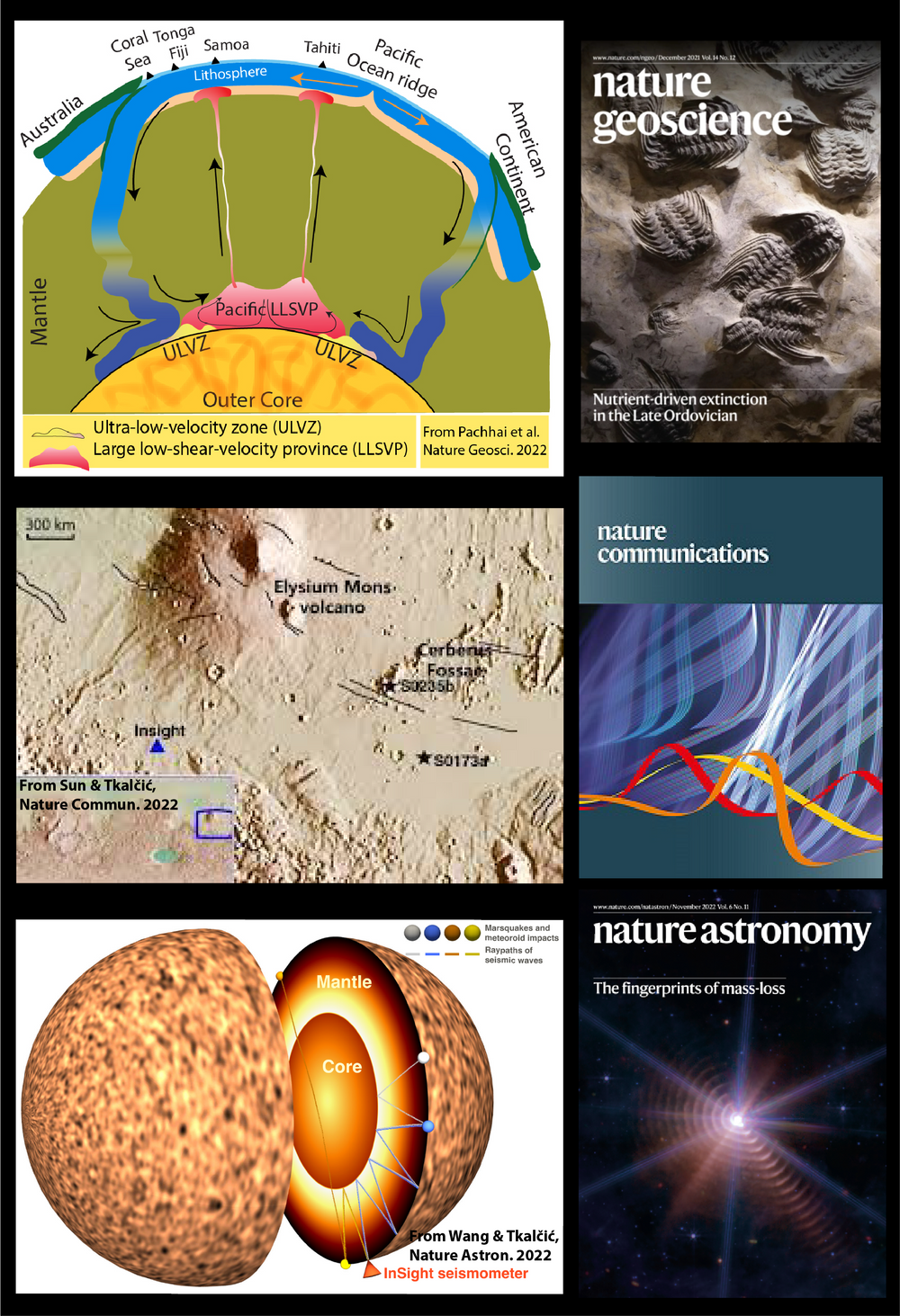2022, IN A NUTSHELL
As the Earth's interior image continued getting sharper, far away, on our planetary neighbour's surface, InSight lost its power but provided continuing records for years of research.
We started the year with an exciting work in which we peered for the first time into the internal structure of ultra-low-velocity zones (ULVZs) at the bottom of the Earth's mantle (1). Although these enigmatic structures (Figure 1; top) have been known for several decades, we have shown using state-of-the-art waveform inversion (hierarchical, transdimensional Bayesian) and geodynamical modelling that they could be the remains of an ancient magma ocean, formed by the collision of Theia with the proto-Earth. The Moon was then formed from the part that was ejected into space. Many world media reported this result, but I simplified the article here for a broader range of readers: ULVZs – LEFTOVERS OF EARTH’S VIOLENT PAST
In a review paper invited for the 50th issue of Annual Reviews of Earth and Planetary Sciences, we reported on the shear properties of the inner core (2). What does the research of shear waves in seismology and mineral physics at high pressures and temperatures mean for the past, present and future of the inner core? How fast it grows, how old it is, what its internal structure is like, and where this scientific field is going in the 21st century are just some of the questions we tried to answer in the article. I wrote more about this topic here: SHEAR IN THE EARTH'S INNER CORE
We continued the year by discovering and reporting 47 low-frequency, repetitive quakes on the Red Planet - marsquakes that had not been detected by conventional methods used by the InSight's team of scientists (3). The existence of those marsquakes suggests magmatic activity beneath the surface of Mars, which means that it is not a geologically dead planet (Figure 1; middle). Numerous media reported this discovery, and my blur about it with several links is here: RESTLESS MARS
We then returned to the very heart of our planet via waves that propagate through the interior along the Earth's diameter, very close to its centre (4). From the measurement of their travel times, we confirm that the properties of the inner core in its very centre are different from the outer parts of the inner core. Namely, the waves in the so-called innermost-inner core travel slowest at an angle of about 60 degrees relative to the Earth's rotational axis. In the outer parts of the inner core, the situation is somewhat different - there, the slowest waves are in the equatorial plane. This invited paper is due to appear as a chapter in a new book published by the American Geophysical Union in mid-2023.
In another paper on the inner core, we confirm the existence of the innermost inner core through the Earth's correlation wavefield, i.e. new data and the application of a new method (5). Its existence points to a possible cataclysmic event in Earth's history that changed the nature of crystal growth or the convection regime in the liquid core. This may have left behind a fossilized structure in the centre to which seismic waves we use are sensitive. I simplified this paper's findings here: DIGGING DEEP INTO THE EARTH'S INNER CORE: https://www.facebook.com/permalink.php?story_fbid=pfbid02HxWTLVy1bHyRwdaCx7arx5yctMms3zWP9un49J8HFUd1tUvVzrWL8WrukyCKqsuzl&id=100013873788242
We then go to the Earth's deep mantle, at a depth of 2900 km, where the silicate mantle turns into a liquid core. Here, at the most extreme border in the interior of the planet, more extreme even than the Earth's surface, apart from heterogeneous structures of different sizes, we find by innovative seismic tomography quite expressive topographic relief (6). In some places, the mountains rise to about 10 km, and the valleys descend by the same amount below the average level. I wrote more about it here: SURPRISE AT THE CORE-MANTLE BOUNDARY https://www.facebook.com/permalink.php?story_fbid=pfbid031HEWNFNybGJM64pj7ZjaDzae1JHiudnZKyMxZeBkkCU2UxzTzbHaYSa3yc7SyZXPl&id=100013873788242
The outer core of our planet is in a liquid state. That is where the Earth's geomagnetic field is created and maintained through strong motion and mixing hot iron and nickel. The pressures are slightly lower than the inner core, allowing it to remain liquid. Seismic waves reveal stratification near its top, which could represent lighter chemical elements that have been deposited there over millions of years. Using the Earth's correlation field, we peered for the first time into all the depths of the outer core (7). I wrote more about this work here: THE EARTH'S OCEAN OF IRON
https://www.linkedin.com/pulse/earths-ocean-iron-hrvoje-tkal%C4%8Di%C4%87/
Towards the end of the year, we soared into space again, to Mars and other planets to which we will soon send missions. The core of Mars was discovered last year from records of Martian seismic waves that bounced off it. However, in this paper, we propose an innovative method of scanning the cores of Mars and other planets from waves that are emitted from the focus of a quake or a meteorite impact through the interior multiple times as an echo and are recorded hours later by the sensor of a single seismograph (8). Instead of a signal, we measure their similarity, and from this, we can document the existence of the core and measure its radius (Figure 1; bottom). The world media reported more about the results of this work, and I wrote here: SCANNING FOR PLANETARY CORES
All in all, a great year! We won't easily repeat the success of the discovery, the combination of curiosity and innovation, and the publication of that many significant results in less than 12 months, but if recent results are any indication of what's to come, then 2023 won't look bad either! 🍀
_______________________________
(1) Pachhai, S. M. Li, M. S. Thorne, J. Dettmer, and H. Tkalčić, Internal structure of ultralow-velocity zones consistent with origin from a basal magma ocean, Nat. Geosci., 15, 79-84, https://doi .org/10.1038/s41561-021-00871-5, 2022.
(2) Tkalčić, H., S. Wang, and T-S. Phạm, Shear properties of the Earth's inner core, Ann. Rev. Earth Planet. Sci., 50, https://doi.org/10.1146/annurev-earth-071521-063942, 2022.
(3) Sun, W. and H. Tkalčić, Repetitive marsquakes in Martian upper mantle, Nat. Communi., 13, 1695, https://doi.org/10.1038/s41467-022-29329-x, 2022.
(4) Tkalčić, H., T. Costa de Lima, T-S Phạm, and S. Tanaka, Inner core anisotropy from antipodal PKIKP travel times, AGU monograph, accepted for publication, 27/02/22, 2022.
(5) Costa de Lima, T., H. Tkalčić, and L. Waszek, A new probe into the innermost inner core anisotropy via the global coda-correlation wavefield, J. Geophys. Res., 127, 4, e2021JB023540, https://doi.org/10.1029/2021JB023540, 2022.
(6) Muir, J., S. Tanaka, and H. Tkalčić, Long-wavelength topography and multi-scale velocity heterogeneities at the core-mantle boundary, Geophys. Crisp. Lett., 49, 7, e2022GL099943, https://doi.org/10.1029/2022GL099943, 2022.
(7) Ma, X. and H. Tkalčić, A new view of the Earth's outer core through the global coda correlation wavefield, Phys. Earth Planet. Inter., 106957, https://doi.org/10.1016/j.pepi.2022.106957, 2022.
(8) Wang, S. and H. Tkalčić, Scanning for planetary cores with single-receiver intersource correlations, Nat. Astron., 6, 1272-1279, https://doi.org/10.1038/s41550-022-01796-8, 2022



